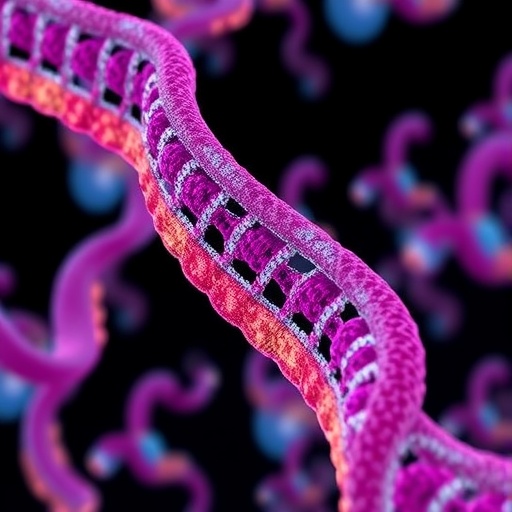In a groundbreaking study published in Nature Protocols, a collaborative research team led by prominent scientists Samy, A., Tham, C.Y., and Dyer, M. has introduced an innovative and comprehensive workflow named NanoVar. This strategic framework is designed to facilitate the detection of structural variants in genomic data, thereby revealing previously hidden patterns within the human genome. The implications of this research are significant, as understanding structural variants is crucial for advancing our knowledge of genetic disorders, cancer genomics, and personalized medicine.
Structural variants, which include duplications, deletions, and translocations of DNA segments, play a pivotal role in the genetic landscape of organisms. These variants can lead to alterations in gene function and regulation, contributing to various diseases and conditions. Despite their importance, traditional methods to detect these structural changes have often been limited by technological constraints and the complexity of genomic data. This is where NanoVar comes in, offering an integrated approach that streamlines the analysis and enhances the reliability of results.
The workflow outlines a rigorous methodology for handling raw genomic data, ensuring that researchers can extract meaningful insights with high precision. By leveraging advanced algorithms and state-of-the-art computational techniques, NanoVar provides an invaluable resource for geneticists and biomedical researchers alike. The ability to detect and characterize structural variants efficiently reduces the time and resource expenditures typically associated with genomic studies.
One of the standout features of NanoVar is its adaptability; it is compatible with various sequencing technologies, including next-generation sequencing (NGS). This versatility makes it an essential tool for a wide range of scientific applications, from population genomics to clinical diagnostics. As researchers increasingly turn to massive data sets to inform their studies, having a reliable and user-friendly framework like NanoVar ensures that they can keep pace with the growing complexity of genomic data.
Importantly, the article emphasizes the significance of open-source research in advancing scientific discovery. By making NanoVar accessible to the global research community, the authors hope to foster collaboration and innovation in the field of genomics. This commitment to transparency will not only empower researchers to replicate findings but also pave the way for further refinements in the methodology.
Moreover, the research highlights the critical role of structural variant analysis in cancer genomics. Tumors often exhibit unique patterns of structural variation that can influence their behavior and response to treatment. By utilizing the NanoVar workflow, researchers can uncover these patterns, facilitating the development of targeted therapies and improving patient outcomes. The ability to dissect the genomic architecture of cancer can enhance our understanding of tumorigenesis and pave the way for novel therapeutic strategies.
The implementation of NanoVar also addresses a crucial gap in existing genomic research. Many current methods for structural variant detection are either too focused on specific types of variants or lack the comprehensive coverage needed to draw generalized conclusions. NanoVar’s framework bridges this divide by providing a holistic approach that encompasses various types of structural changes, enabling scientists to get a complete picture of genomic variation.
In the context of population genetics, the ability to analyze structural variants is paramount for understanding evolutionary dynamics and genetic diversity. NanoVar equips researchers with the tools to investigate how these variants contribute to traits that are subject to natural selection. By examining the distribution of structural variants across different populations, scientists can uncover insights into human migrations, adaptation, and the genetic basis of disease susceptibility.
Furthermore, the authors delve into the technical underpinnings of NanoVar, detailing the computational algorithms that power its capabilities. These algorithms utilize machine learning techniques to enhance the accuracy of structural variant calls, reducing the incidence of false positives and negatives. This precision is essential for ensuring the reliability of conclusions drawn from genomic studies, particularly in clinical settings where diagnostic accuracy can significantly impact patient care.
Another key aspect of NanoVar is its emphasis on user experience. The framework has been designed with researchers in mind, incorporating intuitive interfaces and practical documentation that streamline the workflow. This user-centric approach minimizes the learning curve associated with adopting new technologies, allowing researchers to focus on their scientific inquiries rather than troubleshooting complex software issues.
As genomic research continues to evolve, the demand for robust and efficient tools like NanoVar will only grow. This comprehensive workflow not only enhances our understanding of genetic variation but also democratizes access to cutting-edge genomic research. By facilitating the exploration of structural variants, NanoVar stands at the forefront of a new era of genomic discovery, promising to unveil insights that could transform our approach to health and disease.
In conclusion, the introduction of NanoVar by Samy, A., Tham, C.Y., and Dyer, M. marks a significant milestone in the field of genetics. This innovative workflow not only enhances our capability to detect structural variants but also reinforces the importance of collaborative, open-source research. As scientists harness the power of NanoVar, we can anticipate a deeper understanding of the complexities of the human genome and the myriad ways that genetic variants shape our health.
With the potential to revolutionize genomic studies and clinical diagnostics, NanoVar paves the way for a future where the mysteries of our genetic code can be elucidated with unprecedented clarity and confidence. The implications of this work are vast, reaching beyond the lab and into the lives of individuals and communities worldwide.
Subject of Research: Structural Variant Detection in Genomic Data
Article Title: Publisher Correction: NanoVar: a comprehensive workflow for structural variant detection to uncover the genome’s hidden patterns.
Article References:
Samy, A., Tham, C.Y., Dyer, M. et al. Publisher Correction: NanoVar: a comprehensive workflow for structural variant detection to uncover the genome’s hidden patterns. Nat Protoc (2025). https://doi.org/10.1038/s41596-025-01297-8
Image Credits: AI Generated
DOI: 10.1038/s41596-025-01297-8
Keywords: NanoVar, Structural Variants, Genomic Data, Next-Generation Sequencing, Cancer Genomics, Population Genetics, Machine Learning, Open-Source Research.




